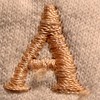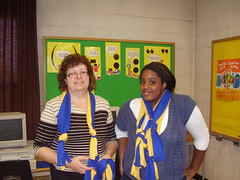Over the last few months I have been using Google docs.
I love the Document, spreadsheet, forms and presentation features.
Here is a sample document where I talk about my favourite book and a teacher librarian that may a difference for me when I was a new teacher.
http://docs.google.com/Doc?id=dhfq3xfw_207fbgvz4qb&hl=en
What's so great about Google docs:
1. It free, unlike the majority of software out there, so move over Microsoft.
2. You never have to play "Where's Waldo" with your work. Saving information on the Internet means you don't need a memory stick, CD or email attachments to transfer your latest work from one station to another. You can view document history and revert back to any previous versions, imagine never loosing your work again.
3. Documents with choice. You can make private documents that are secure, or you can choose to have others help create it and you can publish work with ease. It's all synchronized and saved on the web. They can be collaborative, public or private as needed.
4. Easy to integrate, always improving. Google has a team of engineers coming up with new ways and tools, so it's fully integrated into other web programs and tools from your Google account, IE Reader, Blogger, video, google images etc.
5.Internet not working - no problem, just use Google offline with Google Gears
My previous entries about Google docs:
http://mjpageeducation.blogspot.com/2009/01/google-docs-teachers-in-digital-age.html
http://mjpageeducation.blogspot.com/2009/01/google-forms-for-surveys-quizes-and.html
Sunday, February 22, 2009
Friday, February 20, 2009
Monday, February 16, 2009
Visual learning for the classroom -working with photo's
Using visuals in the classroom always good.
Flickr and Picasa are just a few of the photo tools out there.
Use photos in the classroom to:
Inspire writing, reflections, raise questions etc.
Create a series of events - time capzles with Capzles
Intergrate into a presentation- with slide share
Make photo into a discussion with voice thread
Text to video with Xtranormal
more ideas and sources:
Tom Barrett -35 interesting ways to use your pocket video camera in the classroom
http://docs.google.com/Present?docid=dhn2vcv5_6tv55j7g9
http://matnonline.pbwiki.com/Photo%20Sharing%20to%20Support%20Student%20Achievement
Accessible Educational Technology: A Picture Can Create a Thousand Words
Flickr and Picasa are just a few of the photo tools out there.
Use photos in the classroom to:
Inspire writing, reflections, raise questions etc.
Create a series of events - time capzles with Capzles
Intergrate into a presentation- with slide share
Make photo into a discussion with voice thread
Text to video with Xtranormal
more ideas and sources:
Tom Barrett -35 interesting ways to use your pocket video camera in the classroom
http://docs.google.com/Present?docid=dhn2vcv5_6tv55j7g9
http://matnonline.pbwiki.com/Photo%20Sharing%20to%20Support%20Student%20Achievement
Accessible Educational Technology: A Picture Can Create a Thousand Words
BCHS DECA school spirit scarves for sale
Testing out Flickr. I uploade a photo I had on file. This is from the DECA fundraising event we had last year at our school.
Netbooks - wouldn't it be nice!
With all the online application, in cloud computing, we will no longer need to buy expensive software or expensive hardware. The economic barrier to access for teachers and students could be eliminated. Here's how it works.
According to Tony Vincent- Learning in Hand
http://www.isteconnects.org/2009/02/13/sub-100-netbooks-are-coming/
According to Tony Vincent- Learning in Hand

Two trends in the world of technology are making a big splash in education: web applications and netbooks. These trends excite me because I'm all about easy, free, and cheap. There are many tasks that used to require software that you can now do from inside of your Web browser.... Web apps are great for students and teachers because they are usually free and do not require software to be installed. Because they run in a web browser, web apps are cross-platform, so it doesn't matter if you are running Windows, Macintosh, or Linux operating systems. Because Web apps and their data are stored online, students and teachers can access the apps and data from anywhere (this is called cloud computing). Teachers and students can access web apps on any school computer and also their computers at home. Some web apps even give access on mobile devices. Another bonus: web apps tend to facilitate online sharing and collaboration.Wes Fryer is among others that predict that netbooks will cost < $100. soon.
http://www.isteconnects.org/2009/02/13/sub-100-netbooks-are-coming/
We need to embrace digital curriculum in our schools and colleges NOW, andI purchased a small netbook and can't wait see them as a viable learning tool in the classroom. Leaving the traditional classroom labs to computer programing and specialized classes.
digital curriculum mandates student access to digital devices. The 1:1 learning
revolution is drawing nearer, and announcements like this one about a $20 laptop
from India is a signal that day is even closer.
Add visuals to tags, bookmarks,
I was just reading Larry Ferlazzo blog and tried out the Favthumbs as a way to share those bookmarks and items tagged with Del.icio.us with students.
The Favethumbs looks like a neat tool. Here mine:
http://favthumbs.com/mjpage1234
Check out Larry's blog for more ideas.
http://larryferlazzo.edublogs.org/2009/02/15/the-best-sources-for-internet-scavenger-hunts-webquests/
The Favethumbs looks like a neat tool. Here mine:
http://favthumbs.com/mjpage1234
Check out Larry's blog for more ideas.
http://larryferlazzo.edublogs.org/2009/02/15/the-best-sources-for-internet-scavenger-hunts-webquests/
TOOLS TO CREATE SIMPLE INTERNET SCAVENGER HUNTS:
There are several simple web applications that teachers can use to easily have a list of websites where students can go to find the answers to specific questions on a scavenger hunt. The ones I list here are particularly accessible to English Language Learners because they provide screenshots of the websites as well as their url addresses, and they also don’t require a teacher to register to use them, either. They include:
FAVTHUMBS: Favthumbs provides thumbnail images (and links) of bookmarks saved on your del.icio.us account. Favthumbs might just be one of the easiest ways for a teacher to create an accessible webpage for students doing an Internet “scavenger hunt”, or if they just want their students to focus on a few specific webpages for an assignment. All a teacher has to do is create a tag on their del.icio.us account and give students this url address — favthumbs.com/ (your del.icio.us username)/ (the tag you gave the links). Students will see thumbnail images and links to the sites you’ve bookmarked.
MINMU: With MinMu, all you do is paste the url addresses of as many webpages as you want into a box (no registration is required), and you are given one url address for all of them. Click on it, and you’re shown a screen that not only shows the links to all of the sites, but also thumbnail images of them.
Sunday, February 15, 2009
Free tv ,video, movies

Yes the internet is making everything cheaper, faster, and easier to access.
Check out this link for your favourite TV program, educational materials are available her too.
http://surfthechannel.com/
Saturday, February 14, 2009
Spelling with Flicker Photo's








You can create cool spelling headers to use as labels or banners.
I made this one using:
Flickerhttp://metaatem.net/words/
Social tags & bookmarks, - like tea & cookies, they go together
Del.icio.us is a way to create and use tags.
What potential do I see for this tool? e.g., for teachers, for students, for class assignments, for curriculum development.
Well I do agree that using social bookmarks or taging is better using a web service lic Delicious than marking favorites on a specific computer. The extra advantage is that you can look up a url and see how others have tagged it- this will lead you to more sites with relevant content. However I guess I need more time to work on the social sharing part. I think its like looking at a picture not all eyes will have the same perspective nor the same words to describe a site.If there is a course project, or specific topic that you want to have information on you can use your tags in delcious search, but personally I like using my Google reader for that too,- with the Reader I get the site and the summary of the articles.
Digg is also a popular tagging.I have heard a lot about it for educators but haven't tried it yet. so at this point I'm not sure how each of the following compare: Delecious, Digg, Reader or even advanced Google searches, or data base searches - they all find websites and store the ones we want to return to.
for more on social bookmarking:
http://web2tutorial.wikispaces.com/social_bookmarks
Labels:
del.icio.us,
delicious,
digg,
soical bookmark,
tagging,
tags
Social Networks for education

No doubt that social networking is changing everything, Business, politics, health care and sooner or later, education. 21st Century learners use web 2.0 tools already. Facebook is a popular site and often banned by teachers and restricted by a lot of educational institutions. OK, I admit I had a Facebook account by update and post information less that 5 times a year. Many teens, or adults check and update information 5 times a day! The tool itself is just a tool. It has good features and others that are really just a distraction. There are lots of legitimate business, college and university sites and groups in Facebook, I even found our Local Mayor has a site. I found some for online learning and web 2.0. I guess my biggest concern about using Facebook for education with high school age students is that it may not be perceived as professional and supported by other teachers, parents. Students may have a hard time distinguishing between their personal life, friends and academic uses. I guess web 2.0 tools have so much to offer that I would put this one at the bottom of the list, to avoid the controversy. I can see using it for a particular task, like the student in my civics class who started a environmental petition and web site as part of his final assignment but not as ongoing assignment, work area. I guess I'll take the wait and see approach on this one.
There are other excellent social networking sites out there that you can create for free. This offers the teacher more control on setting, access and can block any inappropriate users. I'm testing one out this semester, have to coach the students along the way, they are eager to jump in and all get how to use it because it's so much like Facebook, but have to keep the conversation on topic. I'll have to let you know how it goes once we have used it a bit more.
http://bchscivics.ning.com
other sources:
http://edtechpower.blogspot.com/2009/02/two-for-tuesday-21009.html
How to set up privacy for Facebook
http://www.scribd.com/doc/2539024/Facebook-Privacy
Advancing K-12 Technology Leadership, Consortium for School Networking(CoSN) Video
Google Earth -explore the ocean floor or travel back in time.
google earth-has some exciting new features that will be of interest to educators.
historical time and view ocean floor.
http://edtechvision.org/?p=530
historical time and view ocean floor.
http://edtechvision.org/?p=530
Friday, February 13, 2009
Don't miss a Date- even when it's not Valantines Day!
something new to try to keep tack of everyting.
Saturday, February 7, 2009
Blog,Blogs, Blogging, but Never Boring!
What's a Blog anyway?
A Blog is a type of web site, that anyone,regardless of age, expertise, computer skill can create in minutes! All you need is a keyboard and access to the Internet. No special program or programming skills,are required. Nothing to buy. Postings or entries are usually like a journal or diary and are posted in order of date. Blogs can be public for anyone to read on www or private if you want, but why hide all your great work? Having an authentic public audience for what you publish is one of the big advantages. Anything that in the past could be written or created, can be typed into a blog. Text along with photo's, drawings, audio, video and PowerPoint type of presentations and other great new types of visuals, like wordle and time capsules can easily be embedded. The main difference between a Blog and traditional web site is the ease of use and the ability to bring text to life by sending and receiving comments and feedback from others. Static text is transformed with conversation, connections, reflection and critical thinking. Blogs are exciting opportunities for original content and expression!
Why would you want to create a blog?
It's: Fast,fun,free,easy, paperless,its always available 24.7 worldwide, everywhere, anytime, any language, creative, content driven, meaningful, documents understanding, builds empathy, real life, expressive design, freedom, self directed, motivational, reflective, responsive, emotional, builds literacy, community and connections, it's constructive, concrete, lasting, builds a sense of control, pride in your work, inspirational, multimedia, and more......but never boring!
How can Blogs be used in education?
Blogs are another tool for teaching, much like textbooks, Internet and Power Point, in the sense they can be used by any age and any curriculum. They can be used by students, teachers, administrators or departments, anyone who wants to communicate.
Take a look at a few great classroom blogs:
http://tparent831.edublogs.org/
http://murch.globalteacher.org.au/
http://www.art-on-the-move.blogspot.com/
http://classblogmeister.com/blog.php?blogger_id=17192
What needs to be considered when working with blogs in the classroom?
1. Safety First
Will students use real or code names? first name only or full name.
some experts feel that being anonymous protects kids, while others feel that being authentic and honest and teaching discretion is best for building "Responsible Internet Citizenship" skills for students. Perhaps there should be different "rules" depending on age, grade and purpose of blog.
Here is a good example outlining student terms of use.
http://tparent831.edublogs.org/student-terms-and-conditions/
2. Digital Literacy
We need to help teachers and students understand:the lifelong nature of publishing, determining quality and validity of information. How to read, summarize, analyse and interpret mass information to determine reliability and usefulness. How to quote sources for a blog and give credit. Plagiarism and what Creative Commons is and how to use it. Appropriate group work and each member making contributions.
http://smartbusinesseducation.wetpaint.com/page/Digital+Literacy
3. Access to Technology.
We need to have time available in labs or computers or netbooks in the classroom, with a projector to provide opportunities to coach students through set up Blog and create initial (or all) postings and work through effective commenting process: preview, editing and posting. Provide direction and class discussion on topics to discuss on blogs, as well as background research.
Looking for more information on blogging in classroom check out:
http://wiki.classroom20.com/Blogging
http://www.classroom20.com/forum/topic/listForTag?tag=blogging
http://www.authorship2.com/2008/07/blogging-to-learn/
http://www.needleworkspictures.com/ocr/blog/
Get started with a blog:
I like Google's Blogger or Get your own EduBlog
A Blog is a type of web site, that anyone,regardless of age, expertise, computer skill can create in minutes! All you need is a keyboard and access to the Internet. No special program or programming skills,are required. Nothing to buy. Postings or entries are usually like a journal or diary and are posted in order of date. Blogs can be public for anyone to read on www or private if you want, but why hide all your great work? Having an authentic public audience for what you publish is one of the big advantages. Anything that in the past could be written or created, can be typed into a blog. Text along with photo's, drawings, audio, video and PowerPoint type of presentations and other great new types of visuals, like wordle and time capsules can easily be embedded. The main difference between a Blog and traditional web site is the ease of use and the ability to bring text to life by sending and receiving comments and feedback from others. Static text is transformed with conversation, connections, reflection and critical thinking. Blogs are exciting opportunities for original content and expression!
Why would you want to create a blog?
It's: Fast,fun,free,easy, paperless,its always available 24.7 worldwide, everywhere, anytime, any language, creative, content driven, meaningful, documents understanding, builds empathy, real life, expressive design, freedom, self directed, motivational, reflective, responsive, emotional, builds literacy, community and connections, it's constructive, concrete, lasting, builds a sense of control, pride in your work, inspirational, multimedia, and more......but never boring!
How can Blogs be used in education?
Blogs are another tool for teaching, much like textbooks, Internet and Power Point, in the sense they can be used by any age and any curriculum. They can be used by students, teachers, administrators or departments, anyone who wants to communicate.
Take a look at a few great classroom blogs:
http://tparent831.edublogs.org/
http://murch.globalteacher.org.au/
http://www.art-on-the-move.blogspot.com/
http://classblogmeister.com/blog.php?blogger_id=17192
What needs to be considered when working with blogs in the classroom?
1. Safety First
Will students use real or code names? first name only or full name.
some experts feel that being anonymous protects kids, while others feel that being authentic and honest and teaching discretion is best for building "Responsible Internet Citizenship" skills for students. Perhaps there should be different "rules" depending on age, grade and purpose of blog.
Here is a good example outlining student terms of use.
http://tparent831.edublogs.org/student-terms-and-conditions/
2. Digital Literacy
We need to help teachers and students understand:the lifelong nature of publishing, determining quality and validity of information. How to read, summarize, analyse and interpret mass information to determine reliability and usefulness. How to quote sources for a blog and give credit. Plagiarism and what Creative Commons is and how to use it. Appropriate group work and each member making contributions.
http://smartbusinesseducation.wetpaint.com/page/Digital+Literacy
3. Access to Technology.
We need to have time available in labs or computers or netbooks in the classroom, with a projector to provide opportunities to coach students through set up Blog and create initial (or all) postings and work through effective commenting process: preview, editing and posting. Provide direction and class discussion on topics to discuss on blogs, as well as background research.
Looking for more information on blogging in classroom check out:
http://wiki.classroom20.com/Blogging
http://www.classroom20.com/forum/topic/listForTag?tag=blogging
http://www.authorship2.com/2008/07/blogging-to-learn/
http://www.needleworkspictures.com/ocr/blog/
Get started with a blog:
I like Google's Blogger or Get your own EduBlog
Video vitals
How Youtube can be used in school setting?
My feeling is that videos are vital in the classroom. Having the ability to combine meaningful visuals with music and sometimes text is both attention getting and entertaining for students so they are more receptive to the learning. Many videos are available for live streaming, this can be News, Documentaries or even fun clips that make a teaching point. I admit that Youtube can be a time waster if you leave students to explore on their own without any direction, but there are so many worthwhile clips, the benefits out way the nonsense. I admit I have even encouraged some students to create work and publish it there. With programs like Windows Movie Maker it's relatively a simple process to create video with a few photos, even if from a cell phone camera.
http://chatt.hdsb.ca/~bchs/web/store/index.htm
http://smartbusinesseducation.wetpaint.com/page/Making+videos+in+classroom
Google video- comes with your G-Mail account and you can upload videos and select view options such as search ability or public/ private.
YouTube is not alone in the online video world, there is also TeacherTube , Ustream, Google video, a personal favourite Ted Talks, and most Canadian and World News and Media sources that have streaming video. Most all are FREE and easy to access.
Gone are the days of hunting down a TV and VCR or DVD player for the classroom, with a limited supply of outdated sources. With one computer, projector and speakers you can bring these multimedia sources to the classroom in minutes.
This Sample video is from a series "I selected this one because it illustrates how we live in a "flat world" I find the music and purpose is motivational!
Considerations
Teachers need to Preview clips ahead of time!!
As educators we could do a better job of teaching students:
1. How to find out who published the video
2. Where to look to find credentials of the video creator
3. Pay attention to video credits usually at end of a clip
4. Appropriate and productive use of time and resources
5. Respect for individual privacy
5. How to create meaningful videos
6. How to embed video in Blog, Wiki or web site
7. How to link and embed video into a Presentation with followup discussion questions or activities.
8. How to give credit, source videos in Blog, Wiki, or web site
9. Significance of number of views and ratings
10. Comments on videos
11. Subscription to video
A few Video sources:
http://edutube.org/sitemap
100 best you tube video for teachers.
http://nfb.ca/
http://medianet.hdsb.ca/
To download streamed video to play when Internet is not available.
I never realized how fortunate I am to work in Halton, we limited like many school boards in Canada, US and worldwide where there are a lot of blocked web sites. Seams odd when freedom of information is taken for granted, how will students learn to be responsible if they are never given any choice? but that's another issue. If because of blocking or just as back up you need to download streamed video them at home or when you have access to the internet try using zamzar, keepvid, or TubeTV for Macs. VLC works great for playing the flv videos. Then the Internet is not required to view.
My feeling is that videos are vital in the classroom. Having the ability to combine meaningful visuals with music and sometimes text is both attention getting and entertaining for students so they are more receptive to the learning. Many videos are available for live streaming, this can be News, Documentaries or even fun clips that make a teaching point. I admit that Youtube can be a time waster if you leave students to explore on their own without any direction, but there are so many worthwhile clips, the benefits out way the nonsense. I admit I have even encouraged some students to create work and publish it there. With programs like Windows Movie Maker it's relatively a simple process to create video with a few photos, even if from a cell phone camera.
http://chatt.hdsb.ca/~bchs/web/store/index.htm
http://smartbusinesseducation.wetpaint.com/page/Making+videos+in+classroom
Google video- comes with your G-Mail account and you can upload videos and select view options such as search ability or public/ private.
YouTube is not alone in the online video world, there is also TeacherTube , Ustream, Google video, a personal favourite Ted Talks, and most Canadian and World News and Media sources that have streaming video. Most all are FREE and easy to access.
Gone are the days of hunting down a TV and VCR or DVD player for the classroom, with a limited supply of outdated sources. With one computer, projector and speakers you can bring these multimedia sources to the classroom in minutes.
This Sample video is from a series "I selected this one because it illustrates how we live in a "flat world" I find the music and purpose is motivational!
Photo Movie of "Playing For Change: Peace Through Music" trip to Guguletu, South Africa (Township of CapeTown) where the PFC Foundation is building a new music school this fall that will connect students from there to others at established music schools.www.playingforchange.com
Considerations
Teachers need to Preview clips ahead of time!!
As educators we could do a better job of teaching students:
1. How to find out who published the video
2. Where to look to find credentials of the video creator
3. Pay attention to video credits usually at end of a clip
4. Appropriate and productive use of time and resources
5. Respect for individual privacy
5. How to create meaningful videos
6. How to embed video in Blog, Wiki or web site
7. How to link and embed video into a Presentation with followup discussion questions or activities.
8. How to give credit, source videos in Blog, Wiki, or web site
9. Significance of number of views and ratings
10. Comments on videos
11. Subscription to video
A few Video sources:
http://edutube.org/sitemap
100 best you tube video for teachers.
http://nfb.ca/
http://medianet.hdsb.ca/
To download streamed video to play when Internet is not available.
I never realized how fortunate I am to work in Halton, we limited like many school boards in Canada, US and worldwide where there are a lot of blocked web sites. Seams odd when freedom of information is taken for granted, how will students learn to be responsible if they are never given any choice? but that's another issue. If because of blocking or just as back up you need to download streamed video them at home or when you have access to the internet try using zamzar, keepvid, or TubeTV for Macs. VLC works great for playing the flv videos. Then the Internet is not required to view.
Subscribe to:
Posts (Atom)
